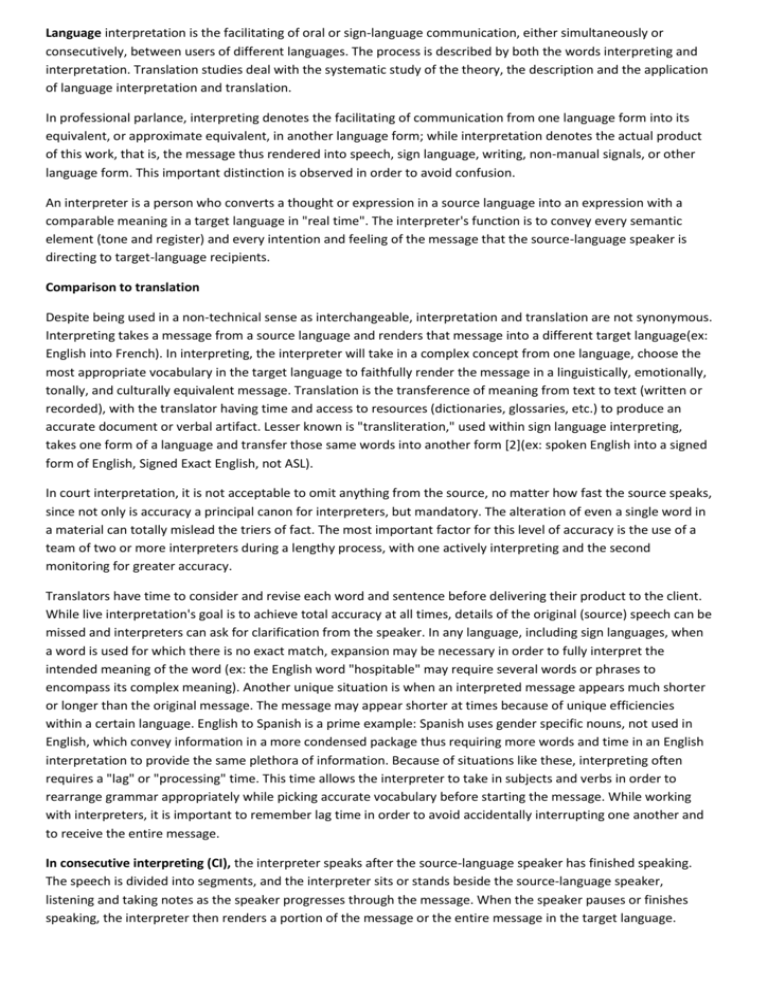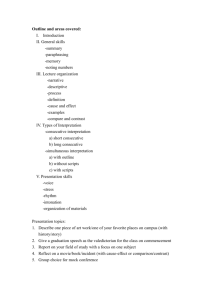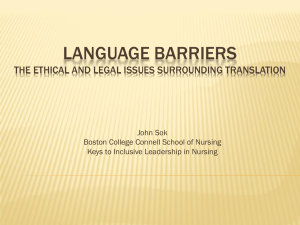Language interpretation is the facilitating of oral or sign
advertisement

Language interpretation is the facilitating of oral or sign-language communication, either simultaneously or consecutively, between users of different languages. The process is described by both the words interpreting and interpretation. Translation studies deal with the systematic study of the theory, the description and the application of language interpretation and translation. In professional parlance, interpreting denotes the facilitating of communication from one language form into its equivalent, or approximate equivalent, in another language form; while interpretation denotes the actual product of this work, that is, the message thus rendered into speech, sign language, writing, non-manual signals, or other language form. This important distinction is observed in order to avoid confusion. An interpreter is a person who converts a thought or expression in a source language into an expression with a comparable meaning in a target language in "real time". The interpreter's function is to convey every semantic element (tone and register) and every intention and feeling of the message that the source-language speaker is directing to target-language recipients. Comparison to translation Despite being used in a non-technical sense as interchangeable, interpretation and translation are not synonymous. Interpreting takes a message from a source language and renders that message into a different target language(ex: English into French). In interpreting, the interpreter will take in a complex concept from one language, choose the most appropriate vocabulary in the target language to faithfully render the message in a linguistically, emotionally, tonally, and culturally equivalent message. Translation is the transference of meaning from text to text (written or recorded), with the translator having time and access to resources (dictionaries, glossaries, etc.) to produce an accurate document or verbal artifact. Lesser known is "transliteration," used within sign language interpreting, takes one form of a language and transfer those same words into another form [2](ex: spoken English into a signed form of English, Signed Exact English, not ASL). In court interpretation, it is not acceptable to omit anything from the source, no matter how fast the source speaks, since not only is accuracy a principal canon for interpreters, but mandatory. The alteration of even a single word in a material can totally mislead the triers of fact. The most important factor for this level of accuracy is the use of a team of two or more interpreters during a lengthy process, with one actively interpreting and the second monitoring for greater accuracy. Translators have time to consider and revise each word and sentence before delivering their product to the client. While live interpretation's goal is to achieve total accuracy at all times, details of the original (source) speech can be missed and interpreters can ask for clarification from the speaker. In any language, including sign languages, when a word is used for which there is no exact match, expansion may be necessary in order to fully interpret the intended meaning of the word (ex: the English word "hospitable" may require several words or phrases to encompass its complex meaning). Another unique situation is when an interpreted message appears much shorter or longer than the original message. The message may appear shorter at times because of unique efficiencies within a certain language. English to Spanish is a prime example: Spanish uses gender specific nouns, not used in English, which convey information in a more condensed package thus requiring more words and time in an English interpretation to provide the same plethora of information. Because of situations like these, interpreting often requires a "lag" or "processing" time. This time allows the interpreter to take in subjects and verbs in order to rearrange grammar appropriately while picking accurate vocabulary before starting the message. While working with interpreters, it is important to remember lag time in order to avoid accidentally interrupting one another and to receive the entire message. In consecutive interpreting (CI), the interpreter speaks after the source-language speaker has finished speaking. The speech is divided into segments, and the interpreter sits or stands beside the source-language speaker, listening and taking notes as the speaker progresses through the message. When the speaker pauses or finishes speaking, the interpreter then renders a portion of the message or the entire message in the target language. Consecutive interpretation is rendered as "short CI" or "long CI". In short CI, the interpreter relies on memory, each message segment being brief enough to memorize. In long CI, the interpreter takes notes of the message to aid rendering long passages. These informal divisions are established with the client before the interpretation is effected, depending upon the subject, its complexity, and the purpose of the interpretation. On occasion, document sight translation is required of the interpreter during consecutive interpretation work. Sight translation combines interpretation and translation; the interpreter must render the source-language document to the target-language as if it were written in the target language. Sight translation occurs usually, but not exclusively, in judicial and medical work. The CI interpreter Patricia Stöcklin renders Klaus Bednarz's speech to Garry Kasparov. The CI interpreter Patricia Stöcklin takes notes on Garry Kasparov's speech. The CI interpreter Patricia Stöcklin renders Garry Kasparov's speech to the audience. Consecutively-interpreted speeches, or segments of them, tend to be short. Fifty years ago, the CI interpreter would render speeches of 20 or 30 minutes; today, 10 or 15 minutes is considered too long, particularly since audiences usually prefer not to sit through 20 minutes of speech they cannot understand. Often, if not previously advised, the source-language speaker is unaware that he or she may speak more than a single sentence before the CI interpretation is rendered and might stop after each sentence to await its targetlanguage rendering. Sometimes, however, depending upon the setting or subject matter, and upon the interpreter's capacity to memorize, the interpreter may ask the speaker to pause after each sentence or after each clause. Sentence-by-sentence interpreting requires less memorization and therefore lower likelihood for omissions, yet its disadvantage is in the interpreter's not having heard the entire speech or its gist, and the overall message is sometimes harder to render both because of lack of context and because of interrupted delivery (for example, imagine a joke told in bits and pieces, with breaks for translation in between). This method is often used in rendering speeches, depositions, recorded statements, court witness testimony, and medical and job interviews, but it is usually best to complete a whole idea before it is interpreted. Full (i.e., unbroken) consecutive interpreting of whole thoughts allows for the full meaning of the source-language message to be understood before the interpreter renders it in the target language. This affords a truer, more accurate, and more accessible interpretation than does simultaneous interpretation.







